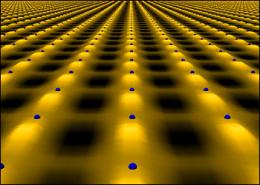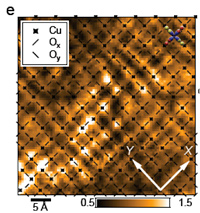July 14, 2010

Enlarge
This pattern shows the tunneling potential of electrons on oxygen atoms “north” and “east” of each copper atom (shown embedded in the pattern) in the copper-oxide layer of a superconductor in the pseudogap phase. On oxygen atoms north of each copper, the tunneling potential is strong, as indicated by the brightness of the yellow patches forming lines in the north-south direction. On oxygen atoms east of each copper, the tunneling potential is weaker, indicated by less intense yellow lines in the east-west direction. This apparent broken symmetry may help scientists understand the pseudogap phase of copper-oxide superconductors.
(PhysOrg.com) -- Scientists have been trying for some 20 years to understand why the low temperature at which copper-oxide superconductors carry current with no resistance can't be increased to be closer to room temperature. Recently, scientists have focused on trying to understand and control an electronic phase called the "pseudogap" phase, which is non-superconducting and is observed at a temperature above the superconducting phase. But what form of electronic order (if any) characterizes the pseudogap phase has remained a frustrating and challenging mystery.
Ads by Google
Light Measurement - Measure all optical parameters of Light: Intensity, Color, Spectrum - www.lightmeasurement.com
Now scientists have discovered a fundamental difference in how electrons behave at the two distinct oxygen-atom sites within each copper-oxide unit, which appears to be a specific property of the non-superconducting pseudogap phase. The research — described in the July 15, 2010, issue of Nature — may lead to new approaches to understanding the pseudogap phase, which has been hypothesized as a key hurdle to achieving room-temperature superconductivity.
"Many people consider the disappearance of superconductivity that occurs when the pseudogap phase emerges as an indication that the pseudogap is the killer of room temperature superconductivity in the copper-oxides," said study leader Séamus Davis, director of the Center for Emergent Superconductivity at the U.S. Department of Energy's Brookhaven National Laboratory and the J.D. White Distinguished Professor of Physical Sciences at Cornell University. "Detecting a difference in electron behavior at the two oxygen sites within each copper-oxide unit at the pseudogap energy may be a very significant step toward identifying exactly what the pseudogap state is and how it affects superconductivity."
To identify the change in electronic behavior, Davis worked with other physicists from Binghamton University, Cornell University, Brookhaven, the University of Tokyo, the Advanced Institute of Science and Technology in Korea, the RIKEN laboratory in Japan, and Japan's Institute of Advanced Industrial Science and Technology. Using a technique known as spectroscopic imaging scanning tunneling microscopy, they measured the relative ease with which electrons could jump from the surface at each individual copper and oxygen site to the tip of the microscope needle. New theoretical approaches pioneered by Michael Lawler of Binghamton and Eun-Ah Kim of Cornell helped the group understand the electron behavior.Across the entire copper-oxide crystal, the scientists found a remarkable difference in the electronic states associated with the mysterious pseudogap phase: The number of electrons able to "tunnel" to the microscope tip differed depending on the position of the oxygen atom relative to the copper atom. "Picture the copper atom at the center of the unit, with one oxygen to the 'north' and one to the 'east,' and this whole unit repeating itself over and over across the copper-oxide layer," Davis said. "In every single copper-oxide unit, the tunneling ability of electrons from the northern oxygen atom was different from that of the eastern oxygen."
The discovery of this asymmetrical behavior could be a breakthrough in understanding and controlling high-temperature superconductors because, historically, uncovering the reductions in symmetry responsible for other states of matter has led to huge advances in understanding and achieving control over those states. For example, discovery of the symmetries broken in liquid crystals eventually led to their control and everyday use in liquid crystal displays (LCDs).

Actual STM image of the cuprate. Copper-oxygen bonds along the X-direction show a higher intensity than those along the Y-direction. There are several possible reasons for the lack of uniformity in the signal, which the researchers plan to study.
The scientists will pursue their pseudogap research, first by looking for a similar broken symmetry in other copper-oxide superconductors. They will also try to determine: how the directional asymmetry in electronic behavior affects the ability of electrons to flow through the system; how that directional dependence might inhibit superconductivity; and eventually, how this might be overcome at temperatures warm enough to make high-temperature superconducting technologies practical.
"The ultimate goal is to discover or create materials that can act as superconductors, to carry electric current with no energy loss, at room temperature," Davis said.
Conventional superconductors, and even the known "high-temperature" varieties, must all be cooled well below freezing temperatures — some near absolute zero, or -273°C — to operate without energy loss. That requires, using coolants like liquid helium or nitrogen, makes them impractical for everyday uses.
"Developing superconductors that operate without the need for coolants would be transformational," said Davis. "Such materials would greatly improve the efficiency of energy-distribution systems, saving enormous amounts of money and updating the electrical grid to meet the needs of the 21st Century."
Provided by Brookhaven National Laboratory (news : web)












